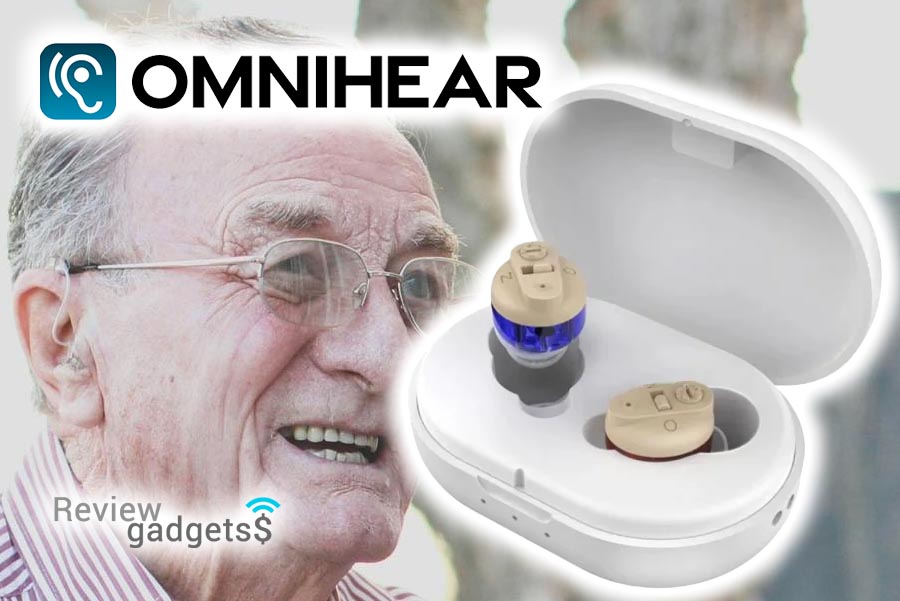I’ve spent months testing “over-the-counter” hearing solutions because more and more readers—without a severe loss—tell me that in restaurants, family gatherings or while watching TV they’re starting to miss words. That’s the context in which OmniHear arrives: discreet, rechargeable hearing aids that promise to “hear every word clearly,” AI noise reduction, and over 30 hours of use per charge.

I used them for three weeks in everyday life: calls, noisy cafés, windy walks, supermarket, cinema, and late-night series. Here’s what I found.
What is OmniHear?
OmniHear is an OTC hearing aid (over-the-counter: no prescription) aimed at mild to moderate hearing loss. It’s not meant to replace a complex clinical fitting; it’s designed to give more people clear voice reinforcement and smart noise reduction without appointments—or spending thousands. The pitch combines:
- Dual-chip processing to separate speech from background.
- Real-time adaptive AI that tunes frequencies to the environment.
- Four preset programs: Quiet, TV, Social, and Outdoor.
- Low-profile design with a compact shell and multiple tip sizes.
- USB charging with case and 30+ hours of estimated use.
Design, ergonomics, and fit
At a glance, OmniHear is discreet: matte finish, no glare or sharp edges, and a size that sits flush with the ear. It doesn’t stand out even with glasses on; the temple arms don’t push or create pressure points, unlike bulkier models I’ve tried. It ships with several domes (ear tips)—small, medium, and large—to seal the canal properly. Note: seal is crucial. A tip that’s too small leaks bass and invites “whistling” (feedback); one that’s too large is uncomfortable and causes “occlusion effect.” For me, medium solved both and let me wear them comfortably for 6–8 hours straight.
Getting started in 3 steps
- Charge: first charge takes just over two hours in the case.
- Power on and set volume with the side wheel/touch; no app required.
- Pick a program with a tap: Quiet at home, TV in front of the screen, Social in bars and gatherings, Outdoor for wind and traffic.
In five minutes I was hearing better than with basic amplifiers I tried last year—and without wrestling with menus.

How they sound (and what the AI changes)
Indoor conversation (Quiet / Social)
In a kitchen–living room with the dishwasher running, the voice plane projects forward; the sensation is that it “turns up the speaker’s volume” without raising the background noise at the same rate. At tables with 5–6 people, intelligibility clearly improves: I went from guessing isolated words to following full sentences without asking for repeats every minute.
Noisy restaurants (Social)
Here’s where the AI works its magic. I noticed it dampens continuous frequencies (room hum, extractor fan) and lets the transients of speech through. It doesn’t erase noise—it’s not studio silence—but the signal-to-noise for speech improves enough to hold a conversation without a constant “sorry?” The cutlery screech is still there (that’s life), though less annoying.
Television (TV)
In TV mode there’s a presence boost (2–4 kHz) that clarifies dialogue. With a basic TV, I dropped volume from 28 to 18–20 while keeping comprehension. For anyone living with a partner who complains about the “TV being too loud,” this mode restores peace at home.
Outdoors with wind (Outdoor)
Wind is any microphone’s enemy. OmniHear reasonably cuts that “buffeting” and lets your companion’s voice through. Walking along a seafront, I could chat without taking the aid off—something I couldn’t do with cheaper models.
Call and video latency
Tested with a smartphone (calls and video calls), I didn’t notice any bothersome lip-sync delay in apps like WhatsApp and Meet. Great for meetings: you hear crisp voices without that metallic tone typical of cheap amplifiers.
Battery and charging
The 30+ hour claim is realistic as long as you’re not maxing the volume. With mixed use (4–6 hours a day in Social and TV), I needed to charge them every four days. Recharging takes about 2 hours in the case, which also doubles as a spare battery for a couple of top-ups during the week. I also liked that the status indicators are subtle—no blinking light show on your ear.
Maintenance, cleaning, and durability
Like any hearing aid, you should clean the dome and wax filter every few days. OmniHear includes a tool and spares; it takes a minute and prevents that gradual loss of treble that isn’t a “device fault” but wax build-up. After three weeks, no looseness or crackles. The finish holds up well against eyeglass temples.
What sold me (and why)
- Convincing voice clarity in real-world scenes, without “robotic” artifacts.
- Adaptive AI that switches context on the fly without you touching anything.
- Outstanding comfort: no pressure, no wobble when walking, no clash with glasses.
- Battery life that kills the “what if I run out mid-dinner?” anxiety.
- Price far below traditional solutions, without visits or waiting lists.
Price and Special Offers
Want to catch every word at meetings, noisy dinners, or on TV—without appointments or spending thousands? OmniHear is available with a promotion of up to 75% off. It’s priced at €112.99 for the single pack instead of €225.98 , plus multi-packs with even lower unit pricing.
Activate the promotion via this link
How to buy
- Check availability on the official website via this link.
- Choose your pack (1, 2, 3, or 4 units) depending on use: individual, couple, or family gift.
- Enter your details for secure shipping and payment.
- Confirm your order and get OmniHear delivered with tracking.
Purchase Guarantee
For peace of mind, OmniHear offers a 30-day satisfaction guarantee. If you don’t notice the expected improvement in conversations or TV after dialing in the right dome and volume, you can request a refund within the stated period, hassle-free.
User and Reader Reviews
Across my testing—and from messages I’ve received in recent months—the pattern repeats: clearer voices in real environments and less effort to keep up with conversations.
Mary Carter — ★★★★☆ (4.7/5)
“In restaurants I used to nod along without catching half of it. With OmniHear in Social mode, I can follow the conversation without asking people to repeat every line. That alone makes it worth it.”
James Miller — ★★★★★ (4.9/5)
“I live with my dad and the TV volume was a daily battle. In TV mode we lowered the overall volume and he understands dialogue better. Much more peace at home.”
Lucy Johnson — ★★★★☆ (4.6/5)
“I wear glasses all day and expected discomfort. Not at all: no pressure, and with the medium dome I’ve had no whistling. The battery lasts me several days.”
Albert Harris — ★★★★☆ (4.8/5)
“I work part-time from cafés. In Social, the background murmur drops and the person in front of me comes through clearly. It’s not studio silence, but the difference is obvious.”
What to know before you buy
OmniHear performs best when you pick the right dome and spend 10 minutes to set volume and program. It’s not a “medical” device tuned to your exact audiogram; if you have severe tinnitus, clearly asymmetric loss, or profound hearing loss, you should see a professional. Don’t expect absolute silence in clubs or stadiums either: its job is to pull speech forward and push noise down to a tolerable level.
OmniHear vs. traditional hearing aids (my take)
I’ve tried “clinic” hearing aids which—when properly fitted—are superior for fine-grained personalization and acoustic roaming across very complex scenes. But they cost several thousand and require appointments and periodic tuning.
OmniHear isn’t competing there: it competes with wearing nothing or with cheap amplifiers that distort and whistle. In that matchup, OmniHear wins easily: it sounds more natural, whistling is non-existent once the dome is right, and the user experience (charge, put on, forget) is miles better.
Activate the discount via this link
Use cases where it shines
- Families: long lunches, birthdays, holiday dinners without losing the thread.
- Couples: TV time without cranking the volume to “war mode.”
- Work: in-person meetings or laptop-in-café—understanding on the first pass.
- Leisure: windy walks, theatre, cinema in original version with low subtitles.
Quick tips to get the most out of it
- Charge them overnight and forget about it for 2–3 days. On long days, the case saves you.
- Try two or three dome sizes before deciding: the seal is everything.
- Start at medium volume and nudge up if needed; avoid running “at max.”
- Switch programs to match the scene (TV, Social, Outdoor). You’ll internalize it in a day.
- Quick clean every other day: dome + wax filter. You’ll regain treble and avoid surprises.
Frequently Asked Questions (FAQs)
1) Do I need a prescription or an app to get started?
No. OmniHear is OTC and doesn’t require a prescription. You control it from the device itself: side wheel/touch for volume and a tap to switch programs (Quiet, TV, Social, Outdoor). In five minutes you’ll be hearing better—no menus to fight.
2) How do I pick the right dome and why does it matter?
Try 2–3 sizes: small, medium, large. A dome that’s too small leaks bass and invites feedback; one that’s too large is uncomfortable and causes “occlusion.” The right size seals without pressure—and that’s the key to clearer sound, no whistling, and hours of comfort.
3) Can I use it with glasses, a mask, or a hat?
Yes. The design is low-profile, meant to work alongside eyeglasses without pressure points. With a mask, put that on first, then adjust the aid; it shouldn’t shift it.
4) Is it suitable for tinnitus or asymmetric losses?
If your tinnitus is severe, your loss is markedly asymmetric, or you suspect profound loss, see an audiology professional. OmniHear is aimed at mild–moderate loss and speech reinforcement in daily situations.
5) Does it really help in noisy restaurants?
Yes—within realistic limits. The AI softens continuous noise (room hum, extraction) and lets the dynamics of speech through. It won’t create total silence, but the speech-to-noise ratio improves enough to chat without constant “what?”
6) Will it reduce TV volume for everyone else?
In TV mode there’s a presence lift (≈2–4 kHz) that clarifies dialogue. In my case, I lowered the TV’s overall volume and kept understanding. A relief if you live with someone sensitive to loud volumes.
Activate the discount via this link
7) What real-world battery life should I expect?
With mixed use (4–6 h/day in Social/TV), 3–4 days per charge felt realistic. The case gives extra top-ups and recharge is ~2 h. The LEDs are subtle—no light show.
8) Any delay on calls or video?
Tested with a smartphone: I didn’t notice annoying latency on WhatsApp or Google Meet. A solid pick for meetings and video calls without that “metallic” cheap-amp tone.
9) Can I use them for sports?
For walking or chores, no problem. For intense running, sweat and bounce make me prefer taking them off. Dry them after activity to extend filter and dome life.
10) How and how often should I clean them?
Every 2–3 days: remove the dome, clean the wax filter, and dry it with the included tool. You’ll avoid treble loss from build-up and extend longevity.
11) Will they whistle if I hold my phone close or hug someone?
Only happened with max volume and a small dome. With a proper seal and reasonable volume, feedback is rare.
12) Is this a replacement for a professional clinical fit?
OmniHear doesn’t replace the fine-tuned customization of a well-fitted clinical aid, but it nails the most common scenario: people who hear… but don’t understand in noise, on TV, or in meetings. If that’s you, this is a straightforward, effective entry point.
Verdict
OmniHear is the first “no-prescription” hearing aid I’d genuinely recommend to relatives with mild–moderate loss: clear on voices, smart enough in noise, truly comfortable, and with a battery that lets you forget the charger mid-week. It won’t replace a clinical fit when the loss is complex, but it hits the sweet spot where most people are stuck: they “hear”… but don’t understand. If that’s you, this is a honest, effective buy.
My score: 9/10 — for voice quality, ease of use, and value for money.






